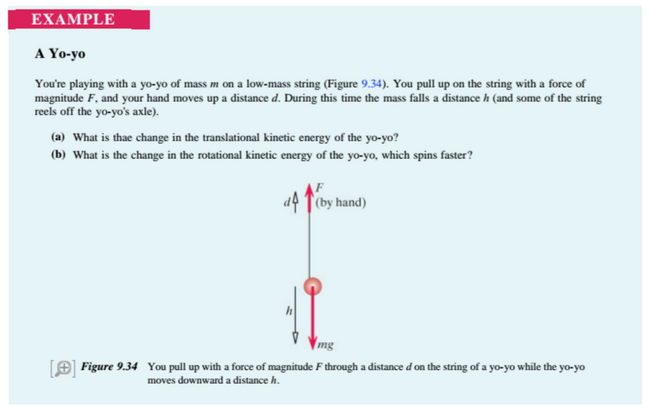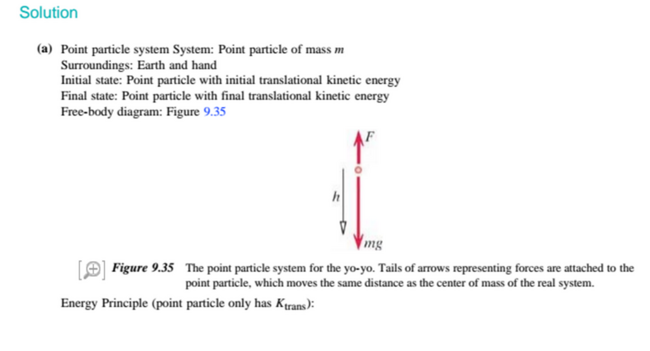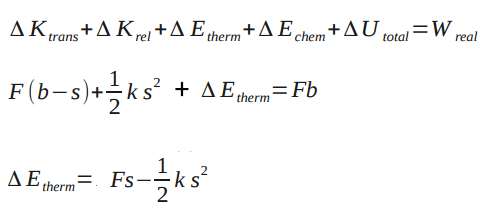Real Systems: Difference between revisions
No edit summary |
No edit summary |
||
| Line 39: | Line 39: | ||
In order to better display the difference of Real Systems from [[Point Particle Systems]], the examples done here will be the same examples done from [[Point Particle Systems]]. | In order to better display the difference of Real Systems from [[Point Particle Systems]], the examples done here will be the same examples done from [[Point Particle Systems]]. | ||
===Jumper Model=== | ===Jumper Model (Simple)=== | ||
[[File:Jumper.png]] | [[File:Jumper.png]] | ||
'''Problem:''' You jump up so that your center of mass has moved a distance '''h'''. How much chemical energy did you expend? | '''Problem:''' You jump up so that your center of mass has moved a distance '''h'''. How much chemical energy did you expend? | ||
| Line 58: | Line 58: | ||
===Yo-Yo=== | ===Yo-Yo (Middling)=== | ||
[[File:Simple.png|650px]][http://www.example.com link title](Chabay) | [[File:Simple.png|650px]][http://www.example.com link title](Chabay) | ||
| Line 78: | Line 78: | ||
Here is where the true difference between Real and Point Particle Systems can be seen. In the Point Particle system, there is no value to account for the change of rotational kinetic energy from the work done the hand. By changing the Work equation to [[File:Workeq.PNG]] rather than [[File:Wppeq.PNG]], the rotational kinetic energy can now be found. | Here is where the true difference between Real and Point Particle Systems can be seen. In the Point Particle system, there is no value to account for the change of rotational kinetic energy from the work done the hand. By changing the Work equation to [[File:Workeq.PNG]] rather than [[File:Wppeq.PNG]], the rotational kinetic energy can now be found. | ||
===Spring In a Box (Difficult)=== | |||
Suppose a thin box contains a ball of clay with the mass '''M''' connected to a relaxed spring with a stiffness '''ks'''. The masses of the box and the spring are negligible. It is initally at rest, and then a constant force of '''F'''. The box moves a distance '''b''' and the spring stretches a distance '''s''' so that the clay sticks to the box. What is the change in thermal energy of the clay after colliding with the wall of the box? | |||
[[File:Springbox.png]] | |||
From the analyzation of the [[Point Particle Systems]] of the Spring in a Box, we know that [[File:Ktransbox.PNG]]. Because the system is a spring, we also know that [[File:Uspring.PNG]]. | |||
[[File:Bssol.PNG]] | |||
==Connectedness== | ==Connectedness== | ||
Revision as of 22:28, 17 April 2016
This topic has been claimed by mwyatt6
The Main Idea
In Point Particle Systems, the only change in energy is from translational kinetic energy because every force is assumed to act on the center of mass. Up until Week 10, we have been measuring change in energy of systems using the Point Particle Method. From what we learned in Week 10 though, we know that translational kinetic energy is not the only type of energy there can be a change in (see: Thermal Energy and Translational, Rotational and Vibrational Energy). In a real system, you must consider the point of application of each force when calculating the change in energy. Also in real systems, forces may also occur over a different displacement than the displacement of the center of mass. These two key differences lead to an interesting mathematical model that differs from that used for the Point Particle Method.
A Mathematical Model
The mathematical equation used for Real Systems can vary depending on what his happening within and on the system. For the sake of flow with the WikiPhysicsBook, we will be analyzing real systems with the energy principle.
(We are ignoring Q for the sake of simplicity. It will not be taken into account in the subsequent examples despite the possible transfer of energy from temperature differences). E is the total energy of the system and W is the net work done from the surroundings on system. The major difference of a point particle system versus a real system is in the calculation of Work. In a point particle system, it is calculated by the net force dot product with the change in the position of the center of mass. However, Work in a real system is calculated by:
This means that the summation of the all the external forces dot product with the distance each force was applied amounts to the total change in energy of the real system. The change in the mathematical equation for Work between a point particle system and a real system is important because now different forms of energy may be taken into account. In a real system, the change in energy of a system can be given by:
Where, total change in internal energy (U) is given by:
total change in kinetic energy (K) is given by:
and change in Miscellaneous Energy is given by:
Examples
In order to better display the difference of Real Systems from Point Particle Systems, the examples done here will be the same examples done from Point Particle Systems.
Jumper Model (Simple)
 Problem: You jump up so that your center of mass has moved a distance h. How much chemical energy did you expend?
Problem: You jump up so that your center of mass has moved a distance h. How much chemical energy did you expend?
From the Point Particle System analysis, we know that and

System: Person Surroundings: Earth+Floor
Initial State: Crouched down
Final State: Extended and moving with speed v
Assuming negligent change in thermal energy and relative kinetic energy, the change in thermal energy is approximately equal to the normal force multiplied by height.
Yo-Yo (Middling)
 link title(Chabay)
link title(Chabay)
Step 1: Solve for translational kinetic energy using the Point Particle System
(The equation for translational kinetic energy here is different than that in Point Particle Systems, so the derivation has been provided.)
Step Two: Solve for rotational kinetic energy using a Real System
Here is where the true difference between Real and Point Particle Systems can be seen. In the Point Particle system, there is no value to account for the change of rotational kinetic energy from the work done the hand. By changing the Work equation to 
, the rotational kinetic energy can now be found.
Spring In a Box (Difficult)
Suppose a thin box contains a ball of clay with the mass M connected to a relaxed spring with a stiffness ks. The masses of the box and the spring are negligible. It is initally at rest, and then a constant force of F. The box moves a distance b and the spring stretches a distance s so that the clay sticks to the box. What is the change in thermal energy of the clay after colliding with the wall of the box?
From the analyzation of the Point Particle Systems of the Spring in a Box, we know that . Because the system is a spring, we also know that

Connectedness
How is this topic connected to something that you are interested in?
- This topic interest me because from one single particle you can mathematically determine the other form of energy that can occur in various physical interaction. In addition, being able to take a large complex interactions whether springs, gravitational potential or rotational energies are involved, you can solve and break down the interactions
How is it connected to your major?
- This topic is not directly connected to my major, but the underlying ideas connect very closely to my major. By first looking at a point particle we have a starting point to looking and breaking down a complex system. As a biochemist there are large complex biological systems that I will encounter in my studies.
While I may not be able to break everything down to one single point, starting off with the simplest path way to understand and comprehend the largest and most complex systems is a similar method to my topic. Like with real and Point particle systems, you start off with a simple point so that one part of the interaction can be understood, from there the rest of the system can be dissected and other interactions can be solved for. With biochemical system, understanding one path, than moving from their to larger paths will help you understand the whole system.
Is there an interesting industrial application?
- I do not really know if their is a physical industrial application that can be seen from looking at real and Point particle systems. However, the methodology and thought process behind looking at a real system can be applied to many problem solving situations.
External links
References
Chabay, Ruth W., and Bruce A. Sherwood. "9." Matter & Interactions. N.p.: n.p., n.d. N. pag. Print.
Wiki Commons Picture
--Nfortingo3(talk) 19:26, 28 November 2015 (EST)








